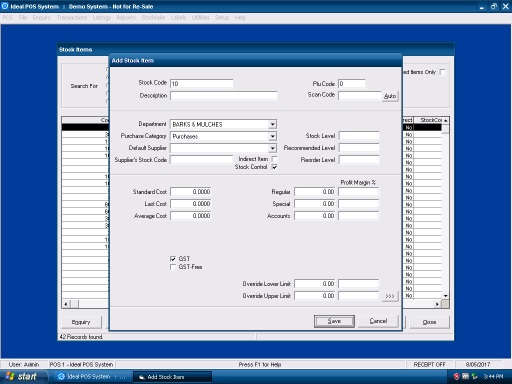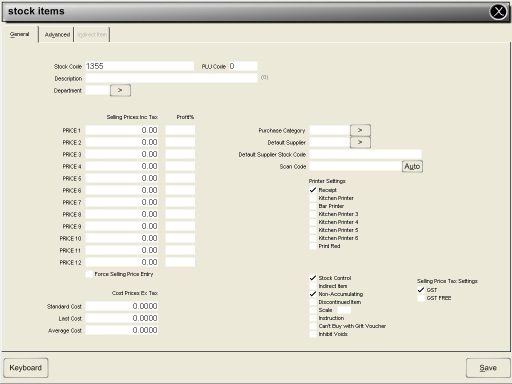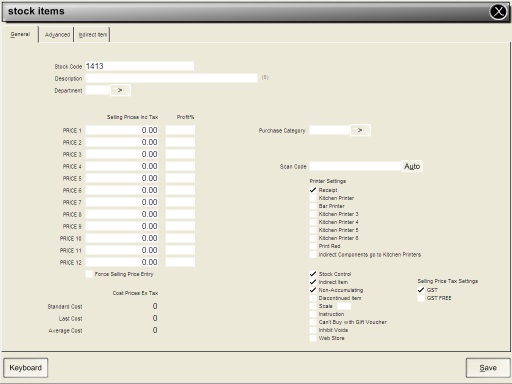Back to blog
09 May
Then & Now - Stock Items
Idealpos has added many features over the years. What started out as a side project for some customer requests, turned into what we have now, Idealpos 7. As Luke talked about in his blog post, Idealpos has come a long way. So much so in fact, that the majority of our current staff would struggle to use the limited features that we started out with. Things that were impossible in Ideal POS System 2.5 are standard and used frequently in Idealpos 7. Inspired by Luke's post, in this series, we're going to go for a trip down memory lane to look at how far we have come with Idealpos to what we know it as today.
When Ideal POS System 2.5 was released in 2001, the very same year that Apple launched the first iPod, it was to be the start of a huge shift here. The Stock Item screen was very minimal, including detail similar to what was available in cash registers at the time. In fact, there were only 44 available options that could be edited to create a stock item. These would allow only 7 price levels with a small number of options on an extra button. Although bare bones, you were able to set par levels, reorder levels, 2 descriptions, sales prompts and print to 3 kitchen printers.

In 2004 we released Ideal POS System 3 and there weren't too many changes to Stock Items as a whole. Although, another 5 price levels were added to make the current total of 12 available. Extra options were added for kitchen printing, specifically being able to select the item as an Instruction and to Print Red. This was also the first time you were able to link a stock item directly to a Menu, as the touchscreen was now being used with buttons. Another addition to stock items was the ability to add Points per Price Level along with the options to choose settings around those points. There was now a total of 78 different options to create a unique stock item.

2006 came and we released Ideal POS System 4. This was a large change in the colours used in the program and the stock item screen was enlarged to fit the full window of a POS terminal. It was also the first year that there was a shortcut direct to Stock Items from the back office. Two tabs were created, General and Advanced. You could now check an option to Force Selling Price Entry, allowing the stock item to not have a set price. The kitchen printers had also been expanded to allow up to 6 different settings. You could now link to more than just Menus, with Grids, Tables and Promotion Tables also being an option. Additional Points options were offered to allow Special Points for the stock item. The number of options to create a stock item increased to 85.

2008 saw us release Ideal POS System 5.0 and there were some large scale changes to stock items. A new tab was added for Indirect Items, so now you didn't have to create a stock item, exit the stock item list, and then configure your indirect items. It could all be done in the one screen. A couple of extra options for the stock items were added to Inhibit Voids and Can't Buy With Gift Voucher. New features created in Ideal POS were starting to creep into stock item settings too. Other than those few little choices though, the stock items remained pretty much the same with a total of 90 options to allow you to configure your items.

In 2009 we released Ideal POS System 5.5. This was the start of having a Framework file, converting databases to SQL and many more changes. Ideal WebIT was born, and with that came an option in Stock Items to select an item as Web Store. We also removed a couple of fields that were no longer required, such as Promotion Table and PLU Code. Apart from those small changes, everything else remained the same, with a smaller total of 88 fields to customise your items.

Idealpos 6.0 was released in 2010 with one small change to Inhibit Discounts, but in 2012 Idealpos 6.03 was released. While not containing a huge amount of new fields, an updated layout was employed to reorganize the screen for better functionality. Borders were implemented and fields moved to better focus on what each setting offered. Dry Cleaning features became standard and so Receipt Tabs were an added field along with National Product Number, bringing the total number of fields to edit your stock items to 95. The stock item shortcut from the dashboard was also no longer permanent, you could select if you wanted the shortcut to be there or not.

Which brings us now to Idealpos 7 which was released in 2016. The layout of the stock item screen changed again, with a brand new colour to boot! Options were condensed on the General tab to change the most frequent items easily, with less used, advanced functions remaining on the Advanced tab. Attribute Types and their Attributes were added to allow better filtering of stock items, and there was now an option to mark an item as Manufactured. Now with 115 different fields to configure a stock item, what more can be added? Only the future knows.
